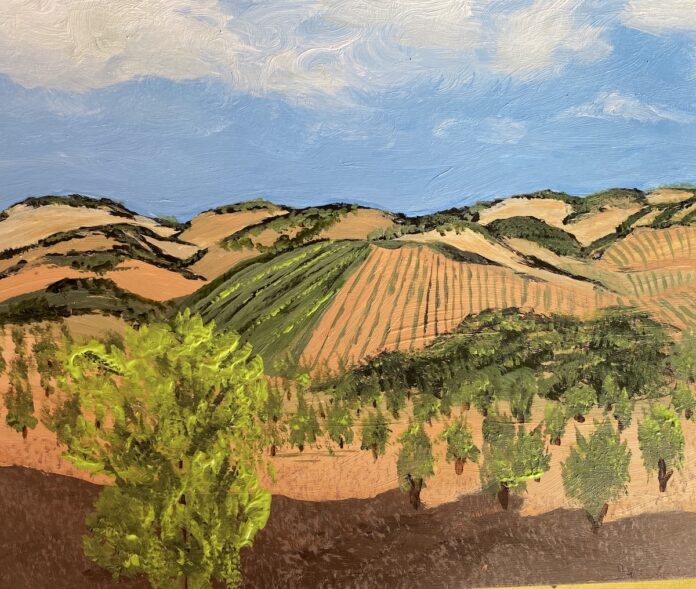No, I don’t mean the remnants of a mess-hall mess-around. This week, Petaluma Arts Center opens Agri-CULTURED, an exhibition exploring the intersections of food and farming in Sonoma County.
The topic of food and the roots of food in the Sonoma County region are, to PAC executive director and exhibition curator Carin Jacobs, inextricably connected to the region, and the show’s food-and-farm focus creates an unmistakable sense of Sonoma County place.
“For me, there is very little that exemplifies a sense of place in Sonoma County [more] than food and the roots of our food,” Jacobs said.
Jacobs, who started as a volunteer and then became a board member, has served as PAC’s executive director for the past year and a half. She has a background in the arts and in food studies, and has long wanted to bring the two together in one space.
Jacobs moved to Petaluma from the East Bay nine years ago. During that time, she witnessed demographic changes, from longtime Petalumans who raised their now-adult children in the city and have been here for generations, to the young couples, families and individuals moving in.
“Sometimes there can be a schism between old Petaluma and new Petaluma, if you will. And I think food is a topic—I hope—that will unite the generations of Petalumans, in a way. I feel like there’s a bridge to be built between both geographies and generations in this area, and I think food can do that,” Jacobs said.
In Sonoma County in general, and Petaluma in particular, the food scene is growing. Institutions such as the Tea Room and Della Fattoria are flourishing, and newer spots like Sol Food and Lunchette on 4th Street are bringing exciting new cuisine options. From an outsider’s perspective, it’s exciting evolution, but change can bring some discomfort, and Jacobs is hoping Agri-CULTURED will build bridges through food; afterall, the dining table is the ultimate equalizer. Everyone’s gotta eat.
Though food- and agriculture-focused, the exhibition does not include a statement on current climate issues in Sonoma County. “I know that there are heated and substantial conversations going on around this topic right now. But this exhibition is about the terroir, sense of place and evolution of the community,” Jacobs said.
Jacobs chose to hold this exhibition now, during an era of increased climate change that might lead attendees to assume it’s directly related to current climate issues, in an effort to re-localize the programming from Petaluma Arts Center.
There was a time when the Center’s exhibitions featured the work of artists from varying geographies in an effort to emulate institutions like SFMOMA. But, in recent years, PAC has focused its vision on a closer geography, showcasing the work of regional artists and addressing regional happenings. Exhibitions that speak to location are the goal now, as PAC seeks to deepen connections to the community, creating an inimitable Petaluma arts niche that can’t be found anywhere else.
With its Petaluma-oriented programming, PAC also seeks to explore the connection between art and life. Science, botany, ecology and biology are all things Jacobs loves to explore with visual art, locating and highlighting unexpected commonalities.
“With Agri-CULTURED, I’m hoping to put artists and farmers in conversation, seeing where the commonalities between the act of creating are in these two worlds,” Jacobs said. “And there’s a poetry portion of the exhibition’s programming, juried by Sonoma County Poet Laureate Elizabeth Heron. I think hearing poetry juxtaposed against the backdrop of the visual art is going to be really interesting.”
There is an experimental quality to Jacobs’ method of curation, almost like a chef combining different ingredients to produce a surprisingly successful dish. This cross-examination of art and life has been part of PAC’s mission since 2016, when Jacobs introduced the Idea Lounge series, which she lovingly refers to as “her baby.”
During Idea Lounge events, two speakers, one from the arts and one from a non-arts-related field, each talk for 20 minutes about their work and processes. The audience then becomes the third speaker, exploring and uncovering connections between the two fields.
“My philosophy of programming and content is taking unexpected elements and putting them together to see what happens, be it in an exhibition or in programming,” Jacobs said. “It’s sort of the Petri dish element of surprise—putting people and objects and ideas in a room together that might never otherwise be in the same place, and seeing what happens!”
Agri-CULTURED’s programming offers a wide variety of opportunities to explore Petaluma through the lens of food.
Opening night, Thursday Aug. 11, promises a great turn-out of community members, artists and Petaluma food purveyors. The aforementioned poetry reading, Food & Memory, is scheduled for Aug. 18 and will view food and agriculture through a poetic, recollecting lens.
On Aug. 25 Douglas Gayeton and Laura Howard-Gayeton will discuss three short films from the Lexicon of Sustainability web series and their work in food education. A Sept. 8 panel discussion with local farmers will consider the current food economy in Petaluma, and, on Sept. 17, historian Katherine J. Rinehart will lead an architectural walking tour of Petaluma’s past and present agricultural history. The show closes on Sept. 24.
With art as the lynchpin and launching pad, Agri-CULTURED explores Petaluma’s relationship with food from a multitude of perspectives.
For more information on this exhibition and PAC’s other programming, visit www.petalumaartscenter.org.











